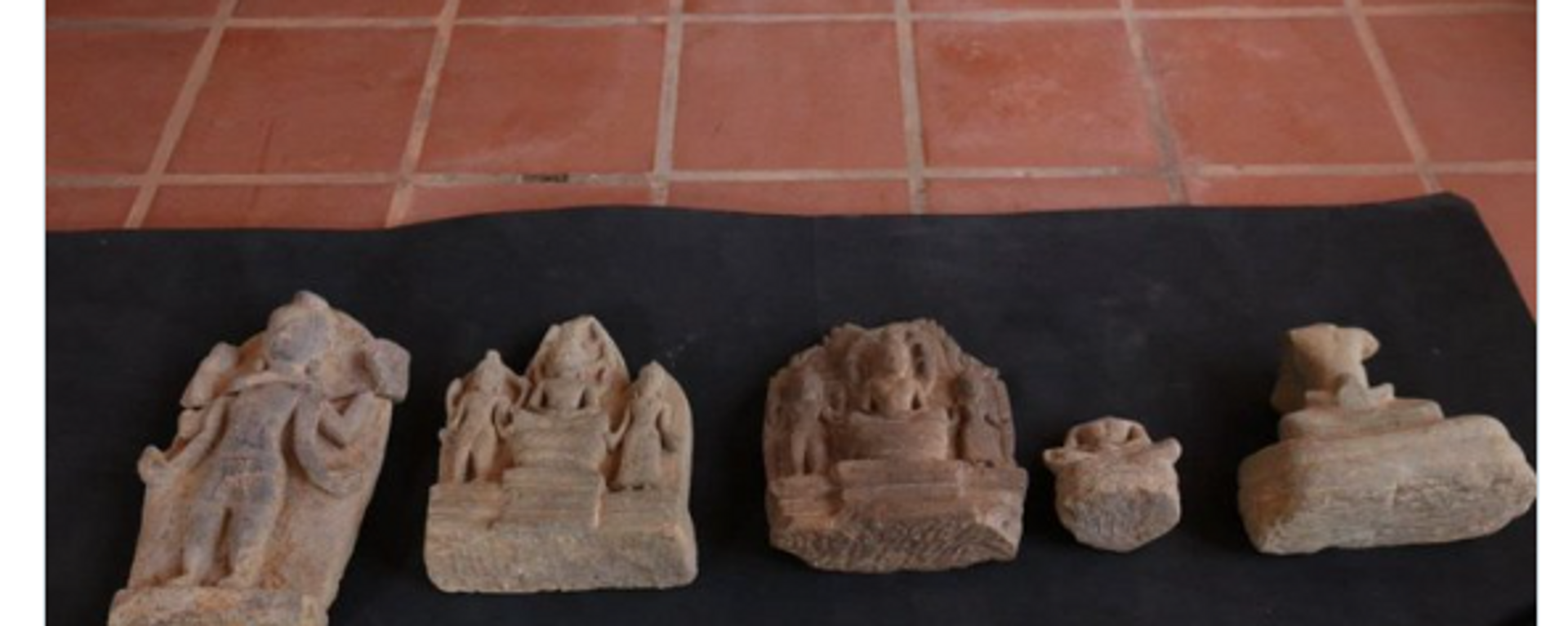https://sputniknews.in/20240502/watch-2500-yo-ancient-artifacts-discovered-during-excavation-in-indias-rajasthan-7270125.html
Watch: 2,500-YO Ancient Artifacts Discovered During Excavation in India's Rajasthan
Watch: 2,500-YO Ancient Artifacts Discovered During Excavation in India's Rajasthan
Sputnik India
For the past four months, Indian archaeologists have been digging a mound in Bahaj village in India's Rajasthan's Bharatpur city in pursuit of unearthing evidence of the lost civilization.
2024-05-02T17:00+0530
2024-05-02T17:00+0530
2024-05-02T17:00+0530
india
rajasthan
archaeological sites
history
cultural heritage
tribal culture
hindu
hindu deities
https://cdn1.img.sputniknews.in/img/07e8/05/02/7269942_0:22:1176:684_1920x0_80_0_0_9efa6a94d826e0573a3f6415c7dbe404.png
The Archaeological Survey of India (ASI) has made a significant breakthrough in unearthing a treasure trove of ancient metal tools, coins, artifacts, and other articles dating back 2,500 years while excavating a mound in Bahaj village in Rajasthan's Bharatpur city.The excavations have revealed several artifacts, including a 'yagya or havan kund' – a vessel where sacred fire is lit while chanting mantras and praying to Hindu Gods. This provides compelling evidence of religious rituals like yagya (sacred fire) being conducted thousands of years ago.The soil from the havan kund, which is considered to be of special significance, has been extracted and kept separate for research purposes, the official said.During the excavation, archaeologists also discovered tools made from bones, as well as ancient baked clay sculptures from the Mauryan period (321 to 185 B.C.E.).The findings also include a stunning pair of statues of Ashwani Kumar, who are revered as the twin Hindu Gods Dstra and Nasatya associated with medicine, health, dawn, and the sciences.Idol plates of Ashwani Kumar of Sunga period and tools made from bones and fragments of pottery believed to be from Mahabharata period have also been discovered.
https://sputniknews.in/20240202/indian-archaeologists-hand-over-five-buddha-statues-for-preservation-to-cambodia-6419657.html
india
rajasthan
Sputnik India
feedback.hindi@sputniknews.com
+74956456601
MIA „Rossiya Segodnya“
2024
Sangeeta Yadav
https://cdn1.img.sputniknews.in/img/07e6/0c/0f/110602_0:0:641:640_100x100_80_0_0_c298016a79eb02ef8caa9d1f688c12a5.jpg
Sangeeta Yadav
https://cdn1.img.sputniknews.in/img/07e6/0c/0f/110602_0:0:641:640_100x100_80_0_0_c298016a79eb02ef8caa9d1f688c12a5.jpg
News
en_IN
Sputnik India
feedback.hindi@sputniknews.com
+74956456601
MIA „Rossiya Segodnya“
Sputnik India
feedback.hindi@sputniknews.com
+74956456601
MIA „Rossiya Segodnya“
Sangeeta Yadav
https://cdn1.img.sputniknews.in/img/07e6/0c/0f/110602_0:0:641:640_100x100_80_0_0_c298016a79eb02ef8caa9d1f688c12a5.jpg
ancient artifacts, excavation, indian archaeologists, lost civilization, archaeological survey of india (asi), ancient, metal tools, coins, artifacts, 2,500 years, bahaj village, bharatpur, rajasthan, vinay gupta, superintendent of archeology with jaipur division, yagya or havan kund', sacred fire, hindu gods, baked clay sculptures, mauryan period, statues of ashwani kumar, twin hindu gods dstra and nasatya, sunga period, mahabharata period,
ancient artifacts, excavation, indian archaeologists, lost civilization, archaeological survey of india (asi), ancient, metal tools, coins, artifacts, 2,500 years, bahaj village, bharatpur, rajasthan, vinay gupta, superintendent of archeology with jaipur division, yagya or havan kund', sacred fire, hindu gods, baked clay sculptures, mauryan period, statues of ashwani kumar, twin hindu gods dstra and nasatya, sunga period, mahabharata period,
Watch: 2,500-YO Ancient Artifacts Discovered During Excavation in India's Rajasthan
For the past four months, Indian archaeologists have been digging a mound in Bahaj village in India's Rajasthan's Bharatpur city in pursuit of unearthing evidence of the lost civilization.
The
Archaeological Survey of India (ASI) has made a significant breakthrough in
unearthing a
treasure trove of ancient metal tools, coins, artifacts, and other articles dating back 2,500 years while excavating a mound in Bahaj village in Rajasthan's Bharatpur city.
“After a long gap of 50 years, excavation work has been started on a large scale in Braj area...The work will continue for some more time and there is a possibility of finding other evidence including some remains,” Vinay Gupta, Superintendent of Archeology with Jaipur Division, told Indian news agency, IANS.
The excavations have revealed
several artifacts, including a 'yagya or havan kund' – a vessel where sacred fire is lit while chanting mantras and praying to Hindu Gods. This provides compelling evidence of religious rituals like yagya (sacred fire) being conducted thousands of years ago.
The soil from the havan kund, which is considered to be of special significance, has been extracted and kept separate for research purposes, the official said.
During the excavation, archaeologists also discovered tools made from bones, as well as ancient baked clay sculptures from the Mauryan period (321 to 185 B.C.E.).
The findings also include a stunning pair of statues of Ashwani Kumar, who are revered as the twin Hindu Gods Dstra and Nasatya associated with medicine, health, dawn, and the sciences.
What makes this discovery even more remarkable is that these
statues date back to the Sunga period (185 to 73 B.C.E). Before this extraordinary find, no evidence of the twin gods had been found in India prior to 700 BC.
Idol plates of Ashwani Kumar of Sunga period and tools made from bones and fragments of pottery believed to be from Mahabharata period have also been discovered.



